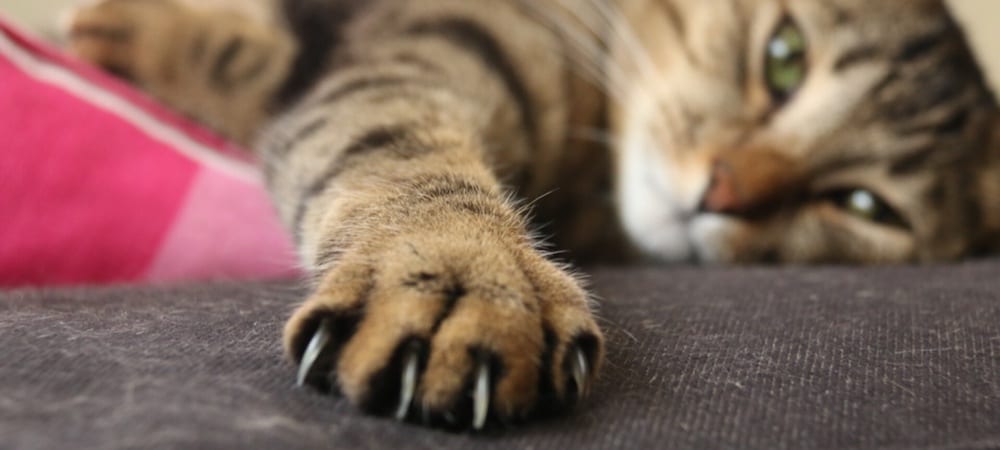Cat-Scratch Fever: Your Guide to Cat-Scratch Disease

This article contains affiliate links. Found Animals receives a portion of the proceeds from every purchase made after clicking on the links. These profits go toward saving more homeless animals!
No, it isn’t just a Ted Nugent song. Cat-Scratch Fever, also known as Cat-Scratch Disease, is actually a real illness. So what kind of disease is it and how can you prevent it? What are Cat-Scratch Fever symptoms and how is the illness treated? Here is our guide to Cat-Scratch Disease.
What Is Cat-Scratch Fever?
Cat-Scratch Disease is caused by a kind of bacteria called Bartonella henselae. Approximately 40% of cats and kittens harbor this bacteria under their nails and in their mouths. Kitties pick up the bacteria by biting at or scratching infected fleas. They might also get it from fighting other cats who carry the bacteria.
Infected cats can then transmit the bacteria to humans through bites or scratches that break the skin. Humans can also get infections if a cat with the bacteria licks the human’s sore, wound or scab. Also, children are more likely than adults to cat Cat-Scratch Disease.
How Is Cat-Scratch Disease Prevented?
There are a few ways to help prevent Cat-Scratch Fever:
- Use caution when coming in contact with outdoor or stray cats.
- Avoid rough-housing with cats to discourage bites and scratches.
- Wash your hands after petting or playing with a cat, especially if you’ve been bitten or scratched, or a cat licks a sore, wound or scab.
- Adopt an adult cat if you have young children or immune issues. Kittens are more likely to carry Cat-Scratch Disease.
It’s also important to always have your cat on a flea prevention medication, such as Flea and Tick Spot Defense or Frontline Plus. You can also try a flea repellent collar or a spray repellant like Natural Flea Spray or Flea Flicker! Tick Kicker! If you end up with a flea infestation in your home, opt for Tropiclean Natural Flea & Tick Carpet & Pet Powder.
What Are Cat-Scratch Fever Symptoms?
The majority of infected cats don’t show Cat-Scratch Fever symptoms. However, some serious cases might result in difficulty breathing or mouth, eye or urinary tract infections. If you notice any of these symptoms, contact your veterinarian immediately!
Not all cat scratches and bites are anything to worry about or warrant a trip to a physician. Signs of Cat-Scratch Disease tend to manifest a few days after contact with the cat. The first symptoms are usually a red sore, bump or blister where the initial scratch or bite was. There may not be much pain, but this could contain pus and crust over.
The bump may heal over, but other symptoms may develop over the next two weeks:
- Loss of appetite
- Swollen glands/lymph nodes (usually close to the bite or scratch)
- Headache
- Fatigue
- Fever
In severe cases, usually in children younger than 5 years old or people with already compromised immune systems, problems could affect bones, eyes, joints, the brain, heart and other organs.
How Is Cat-Scratch Disease Treated?
Cat-Scratch Fever is generally fairly easy to diagnose and might only require a quick review of the patient’s symptoms. However, a doctor might ask for a blood test or take a tissue sample from from the patient’s lymph node.
Cat-Scratch Disease usually doesn’t require much in the way of treatment. In fact, if you’re an adult in generally good health, you probably won’t need any medication. Till you recover from the disease, you can take over-the-counter anti-inflammatories, such as ibuprofen, to help with the pain and swelling. Some folks also find a hot compress to be helpful. In the case of extremely tight and painful glands, a doctor can use a needle to drain excess fluid.
Anyone with existing immune issues or lingering symptoms after two months might require antibiotics. This prevents the illness from spreading to other parts of the body, such as the bones and organs. Antibiotics might need to be taken for several months to fully treat the disease.


